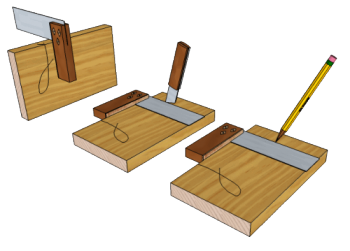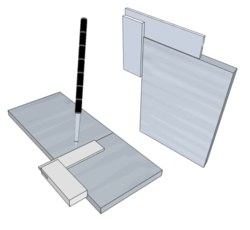Try Square: Difference between revisions
From DT Online
(Created Article) |
m (Added text) |
||
| Line 1: | Line 1: | ||
[[File:TrySquaresTrans.png| | [[File:TrySquaresTrans.png|350px|right]] | ||
[[File:EngineersTrySquare.png| | [[File:EngineersTrySquare.png|250px|right]] | ||
A [https://en.wikipedia.org/wiki/Try_square '''Try Square'''] is an ‘L’-shaped tool used for testing the '''[[Squareness]]''' of material and for marking lines at right-angles to an edge or surface. | A [https://en.wikipedia.org/wiki/Try_square '''Try Square'''] is an ‘L’-shaped tool used for testing the '''[[Squareness]]''' of material and for marking lines at right-angles to an edge or surface using a [https://en.wikipedia.org/wiki/Marking_knife '''Marking Knife'''], [https://en.wikipedia.org/wiki/Pencil '''Pencil'''], or [https://en.wikipedia.org/wiki/Scriber '''Scriber'''] | ||
A traditional '''Carpenter's Try Square''' has a blade of [https://en.wikipedia.org/wiki/Tempering_%28metallurgy%29 '''tempered steel'''] which is fixed at right-angles to a wooden stock with ''' | A traditional '''Carpenter's Try Square''' has a blade of [https://en.wikipedia.org/wiki/Tempering_%28metallurgy%29 '''tempered steel'''] which is fixed at right-angles to a wooden stock with [https://en.wikipedia.org/wiki/Rivet '''rivets'''] passing through [https://en.wikipedia.org/wiki/Brass '''brass'''] plates on each side of the stock. The stock was made of [https://en.wikipedia.org/wiki/Rosewood '''Rosewood'''] or [https://en.wikipedia.org/wiki/Ebony '''Ebony'''] and the brass plates are to prevent the wood from splitting to ensure the blade is held securely. The inside edge of the wooden stock is faced with brass to prevent the stock from wearing. | ||
Modern versions may be made with stocks moulded in [https://en.wikipedia.org/wiki/Composite_material '''plastics composites'''] or [https://en.wikipedia.org/wiki/Die_casting '''die cast'''] in [https://en.wikipedia.org/wiki/Aluminium '''aluminium''']. '''Try Squares''' used by woodworkers have blade lengths typically 150mm and 300mm as measured from inside the stock. | |||
An [https://en.wikipedia.org/wiki/Machinist_square '''Engineer's Try Square'''] is the metalworker's equivalent. It has a metal blade pinned or welded to a steel stock which is notched at the inside corner to prevent small [https://en.wikipedia.org/wiki/Burr_%28edge%29 '''burrs'''] or particles affecting its accuracy in use. | |||
An [https://en.wikipedia.org/wiki/Machinist_square '''Engineer's Try Square'''] is the metalworker's equivalent. It has a metal blade pinned or welded to a steel stock which is notched at the inside corner to prevent small [https://en.wikipedia.org/wiki/Burr_%28edge%29 '''burrs'''] or particles affecting its accuracy in use. Common blade lengths for an '''Engineer's Try Square''' are 100mm and 150mm. | |||
'''Try Square''' type tools are available also as '''[[Squares|Double Squares]]''' and as part of a '''[[Squares|Combination Square]]'''. | |||
[[Category:Secondary]] | |||
[[Category:Marking and Measuring Tools]] | |||
Revision as of 11:59, 19 July 2015
A Try Square is an ‘L’-shaped tool used for testing the Squareness of material and for marking lines at right-angles to an edge or surface using a Marking Knife, Pencil, or Scriber
A traditional Carpenter's Try Square has a blade of tempered steel which is fixed at right-angles to a wooden stock with rivets passing through brass plates on each side of the stock. The stock was made of Rosewood or Ebony and the brass plates are to prevent the wood from splitting to ensure the blade is held securely. The inside edge of the wooden stock is faced with brass to prevent the stock from wearing.
Modern versions may be made with stocks moulded in plastics composites or die cast in aluminium. Try Squares used by woodworkers have blade lengths typically 150mm and 300mm as measured from inside the stock.
An Engineer's Try Square is the metalworker's equivalent. It has a metal blade pinned or welded to a steel stock which is notched at the inside corner to prevent small burrs or particles affecting its accuracy in use. Common blade lengths for an Engineer's Try Square are 100mm and 150mm.
Try Square type tools are available also as Double Squares and as part of a Combination Square.

